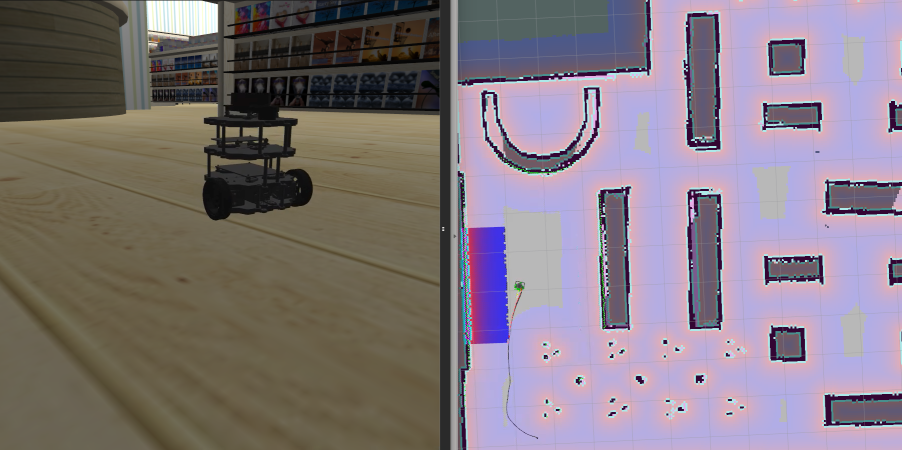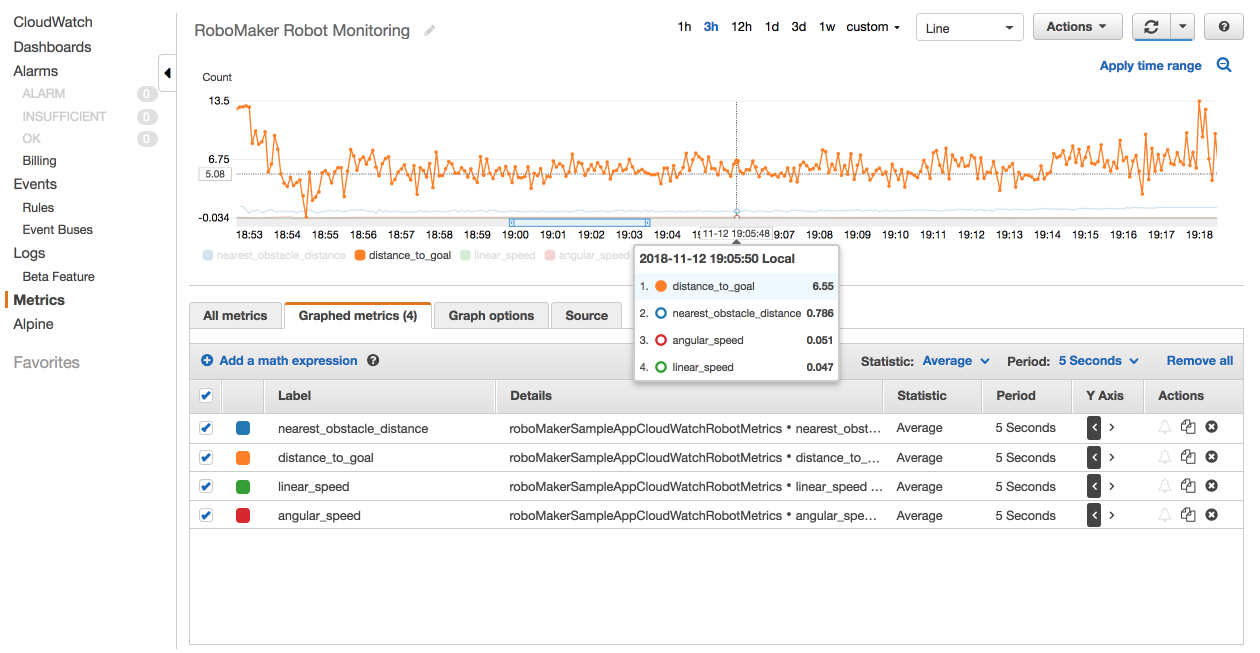Monitor health and operational metrics for a fleet of robots in a simulated home using AWS CloudWatch Metrics and AWS CloudWatch Logs. Streamed metrics include speed, distance to nearest obstacle, distance to current goal, robot CPU utilization, and RAM usage.
It demonstrates how to emit metrics and logs to AWS CloudWatch to monitor your robots.
RoboMaker sample applications include third-party software licensed under open-source licenses and is provided for demonstration purposes only. Incorporation or use of RoboMaker sample applications in connection with your production workloads or a commercial products or devices may affect your legal rights or obligations under the applicable open-source licenses. Source code information can be found here.
- ROS Kinetic / ROS Melodic - Other versions may work, however they have not been tested
- Colcon - Used for building and bundling the application.
You will need to create an AWS Account and configure the credentials to be able to communicate with AWS services. You may find AWS Configuration and Credential Files helpful.
To run this application you will need an IAM user with the following permissions:
logs:PutLogEvents
logs:DescribeLogStreams
logs:CreateLogStream
logs:CreateLogGroup
You can find instructions for creating a new IAM Policy here. In the JSON tab paste the following policy document:
{
"Version": "2012-10-17",
"Statement": [
{
"Sid": "CloudWatchRobotRole",
"Effect": "Allow",
"Action": [
"cloudwatch:PutMetricData",
"logs:PutLogEvents",
"logs:DescribeLogStreams",
"logs:CreateLogStream",
"logs:CreateLogGroup"
],
"Resource": "*"
}
]
}
Follow links above for instructions on installing required software.
sudo apt-get update
rosdep updatesudo apt-get update
rosdep update
cd robot_ws
rosws update
rosdep install --from-paths src --ignore-src -r -y
colcon buildcd simulation_ws
rosws update
rosdep install --from-paths src --ignore-src -r -y
colcon buildThe TURTLEBOT3_MODEL environment variable must be set when running the simulation application (not needed for robot application). Valid values are burger, waffle, and waffle_pi.
Launch the application with the following commands:
-
Running Robot Application on a Robot
source robot_ws/install/local_setup.sh roslaunch cloudwatch_robot deploy_rotate.launch -
Running Robot Application Elsewhere
source robot_ws/install/local_setup.sh roslaunch cloudwatch_robot [command]There are two robot launch commands:
rotate.launch- The robot starts rotatingawait_commands.launch- The robot is idle waiting movement commands, use this for teleop and navigation
-
Running Simulation Application
export TURTLEBOT3_MODEL=waffle_pi source simulation_ws/install/local_setup.sh roslaunch cloudwatch_simulation [command]
There are three simulation launch commands for three different worlds:
empty_world.launch- Empty world with some balls surrounding the turtlebot at (0,0)bookstore_turtlebot_navigation.launch- A retail space where the robot navigates to random goals
Robot logs from ROS nodes are streamed into CloudWatch Logs to Log Group robomaker_cloudwatch_monitoring_example. See cloudwatch_robot/config/cloudwatch_logs_config.yaml.
Robot metrics from ROS nodes are reported into CloudWatch Metrics robomaker_cloudwatch_monitoring_example. Metric resolution is configured at 10 seconds. See cloudwatch_robot/config/cloudwatch_metrics_config.yaml.
Operational metrics include:
- linear speed
- angular speed
- distance to nearest obstacle (closest lidar scan return)
- distance to planned goal (bookstore only, requires its navigation system)
Health metrics include CPU and RAM usage.
You first need to install colcon-ros-bundle. Python 3.5 or above is required.
pip3 install colcon-ros-bundleAfter colcon-ros-bundle is installed you need to build your robot or simulation, then you can bundle with:
# Bundling Robot Application
cd robot_ws
source install/local_setup.sh
colcon bundle
# Bundling Simulation Application
cd simulation_ws
source install/local_setup.sh
colcon bundleThis produces the artifacts robot_ws/bundle/output.tar and simulation_ws/bundle/output.tar respectively.
You'll need to upload these to an s3 bucket, then you can use these files to create a robot application, create a simulation application, and create a simulation job in RoboMaker.
- RoboMakerUtils-Common
- RoboMakerUtils-ROS1
- CloudWatch-Common
- CloudWatchLogs-ROS1
- CloudWatchMetrics-ROS1
- HealthMetricsCollector-ROS1
- MonitoringMessages-ROS1
MIT-0 - See LICENSE for further information
Create issues and pull requests against this Repository on Github

